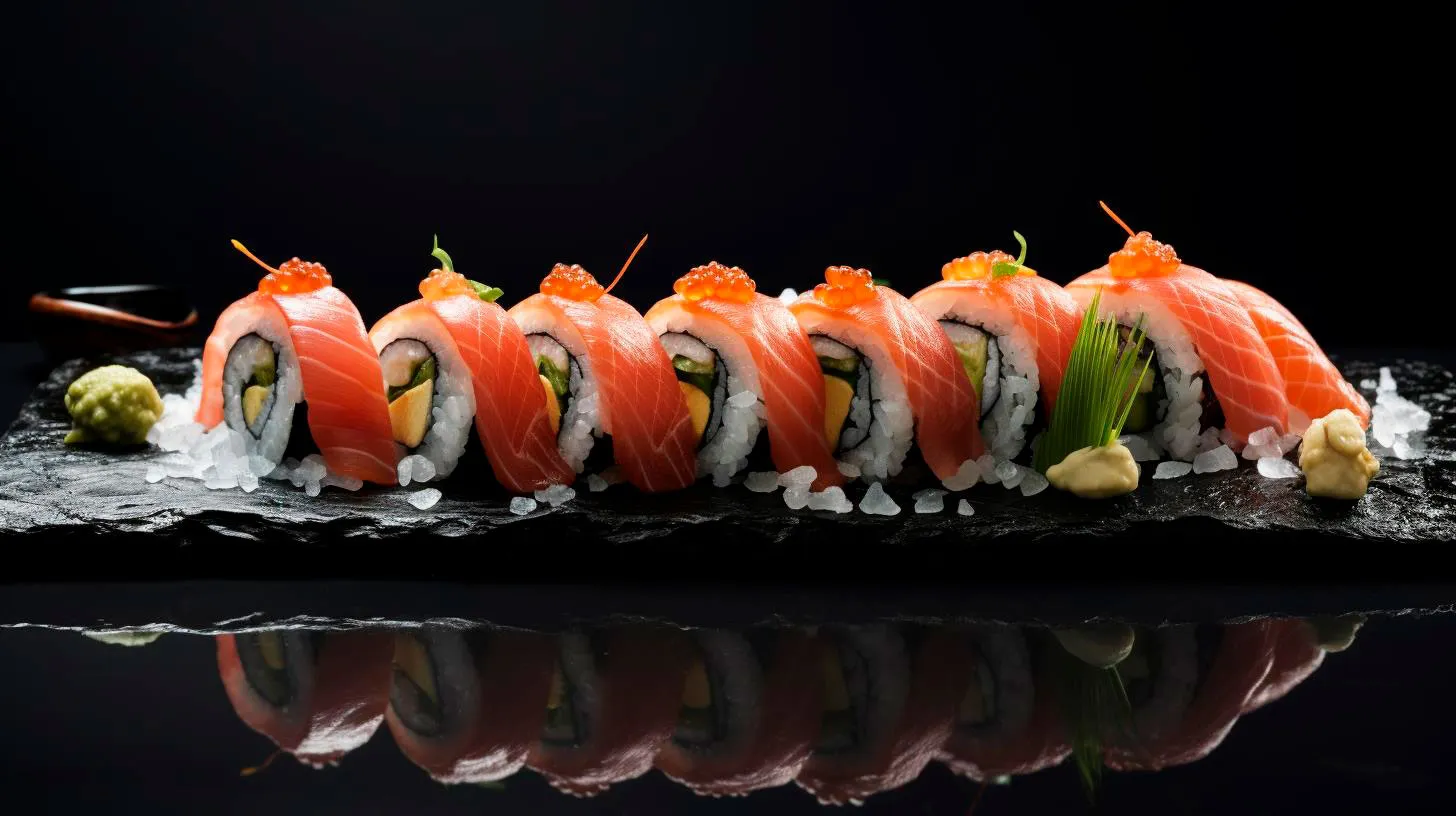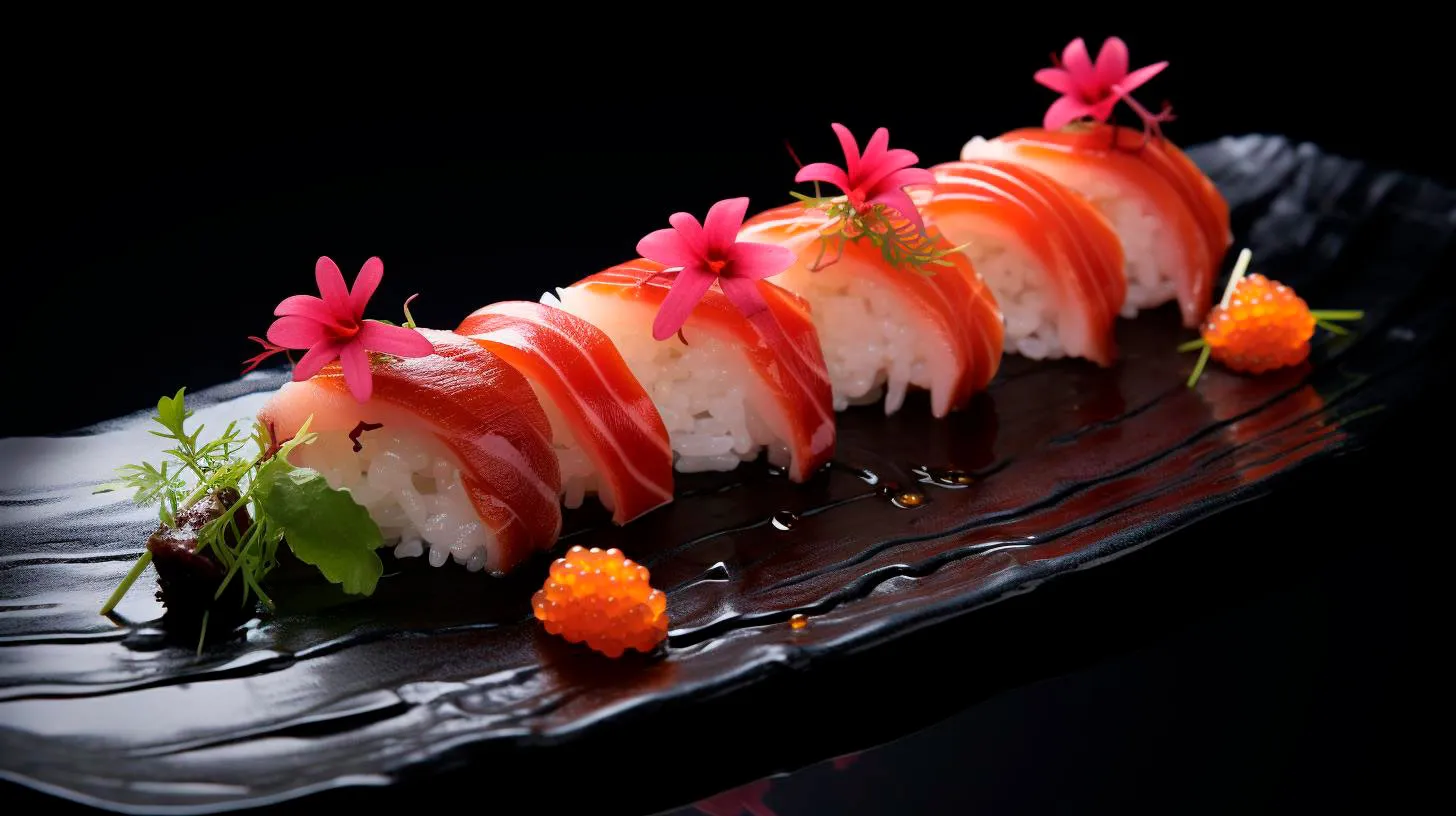Making Sushi Allergy-Friendly: Creative Alternatives and Tips
Ingredients like raw fish, soy sauce, and seafood-based toppings may trigger allergic reactions. But don’t worry, we’ve got you covered! In this article, we will explore creative alternatives and tips to make sushi allergy-friendly, without compromising on taste or presentation.
The Rising Prevalence of Food Allergies
Food allergies have become increasingly common in recent years, affecting millions of people worldwide. According to the World Allergy Organization, approximately 220 to 250 million people have food allergies globally. This rise in prevalence has led to a growing demand for food alternatives that cater to individuals with allergies.
Creative Alternatives to Raw Fish
Raw fish is the iconic ingredient in traditional sushi. However, for individuals with seafood allergies, or those who prefer a plant-based diet, there are several creative alternatives to explore:
1. Vegetable Sushi Rolls
Vegetable sushi rolls offer a delightful burst of flavors while eliminating the need for raw fish. Fillings like avocado, cucumber, carrots, bell peppers, and asparagus lend themselves perfectly to sushi rolls. These ingredients provide a range of textures and colors, making the rolls visually appealing and flavorful.
2. Mushroom Substitutes
Mushrooms are known for their meaty texture, making them an excellent substitute for raw fish. Portobello or shiitake mushrooms, when marinated in soy sauce and other seasonings, can mimic the umami taste found in traditional sushi. They are an ideal choice for individuals who prefer a plant-based alternative.
3. Cooked Seafood
For those with seafood allergies who can tolerate cooked seafood, options like cooked shrimp, crab, or eel can be used as fillings. Cooked seafood retains the desired texture while reducing the risk of triggering allergic reactions.
Alternatives to Soy Sauce
Soy sauce, a staple condiment in traditional sushi, contains wheat and is a common allergen. Luckily, there are alternatives available that cater to various dietary restrictions:
1. Tamari Sauce
Tamari sauce is a gluten-free alternative to soy sauce. Made from fermented soybeans, it offers a similar flavor profile without the wheat component. This makes it a suitable option for individuals with gluten allergies or celiac disease.
2. Coconut Aminos
Coconut aminos are derived from the sap of coconut blossoms and provide a sweet and savory flavor similar to soy sauce. It is both gluten-free and soy-free, making it an excellent alternative for individuals with multiple allergies.
Tips for Allergy-Friendly Sushi Making
When making allergy-friendly sushi at home, it’s important to keep a few tips in mind:
1. Clear Food Labeling
If you have food allergies, always double-check the labels of ingredients and condiments to ensure they are allergy-friendly. Some products may contain hidden allergens, such as wheat or soy.
2. Cross-Contamination Prevention
Prevent cross-contamination by using separate cutting boards, utensils, and preparation areas for allergen-free ingredients. This reduces the risk of accidental exposure to allergens.
3. Communication with Sushi Chefs
When dining out at sushi restaurants, communicate your food allergies to the sushi chef or server. They can guide you towards allergy-friendly options or prepare custom rolls based on your dietary restrictions.
Key Takeaways
- Food allergies affect millions of people globally, leading to a demand for allergy-friendly alternatives.
- Creative alternatives to raw fish in sushi include vegetable rolls, mushroom substitutes, and cooked seafood.
- Tamari sauce and coconut aminos offer alternatives to soy sauce for individuals with allergies.
- Clear food labeling, cross-contamination prevention, and communication with sushi chefs are vital when making and ordering allergy-friendly sushi.
By exploring creative alternatives and following these tips, individuals with food allergies can still enjoy the delightful experience of sushi without compromising their health or taste preferences. Remember, with a little creativity and some allergen-friendly ingredients, the possibilities for allergy-friendly sushi creations are endless!
Exploring Gluten-Free and Allergy-Friendly Sushi Rolls for Children
The Rise of Gluten-Free and Allergy-Friendly Sushi
Gluten-free diets have gained traction in recent years due to an increased awareness of gluten sensitivities and celiac disease. Similarly, more children are being diagnosed with food allergies, making it crucial for restaurants and food establishments to offer allergy-friendly options. Sushi restaurants have recognized this demand and have started offering innovative and delicious solutions for children with dietary restrictions.
Gluten-Free Sushi Rolls
Gluten is a protein present in wheat, rye, and barley, commonly found in traditional sushi rolls. Fortunately, many sushi places now offer gluten-free alternatives, allowing children with gluten sensitivities to enjoy this Japanese delicacy. Here are some popular gluten-free sushi rolls:
- California Roll: Made with crab meat, avocado, cucumber, and gluten-free imitation crab, this roll is a great option for children with gluten allergies.
- Vegetable Roll: Packed with fresh vegetables like cucumber, avocado, and carrots, this roll is not only gluten-free but also rich in vitamins and fiber.
- Sashimi Rolls: These rolls replace the rice with thin slices of fresh fish, making them naturally gluten-free.
By offering these gluten-free options, sushi restaurants ensure that children with gluten allergies can enjoy a delicious and safe meal alongside their friends and family.
Allergy-Friendly Sushi Rolls
Children with food allergies require special attention, particularly when dining out. Sushi restaurants have started catering to this growing demand and providing allergy-friendly options. Here are some allergy-friendly sushi rolls suitable for children:
- Vegetarian Rolls: These rolls are perfect for children with allergies to seafood or meat. Filled with fresh vegetables and tofu, they are both nutritious and safe for consumption.
- Seaweed Substitutions: For children allergic to seaweed, sushi restaurants now offer soy paper or cucumber wraps as alternatives.
- No-Shellfish Rolls: Made without shellfish, these rolls ensure that children with shellfish allergies can safely indulge in sushi.
By accommodating various food allergies, sushi restaurants have made it easier for children to enjoy this popular cuisine without compromising on taste or safety.
The Benefits of Gluten-Free and Allergy-Friendly Sushi Rolls
Aside from catering to dietary restrictions, gluten-free and allergy-friendly sushi rolls offer several benefits for children:
- Variety: Gluten-free and allergy-friendly sushi rolls provide a wide range of options for children, ensuring they never feel left out during sushi nights.
- Nutrition: These rolls embrace fresh and healthy ingredients, such as vegetables, fish, and tofu, providing essential nutrients for growing children.
- Social Inclusion: With gluten-free and allergy-friendly sushi rolls, children with dietary restrictions can enjoy meals with their friends and family at sushi restaurants, fostering a sense of inclusivity.
Key Takeaways
Gluten-free and allergy-friendly sushi rolls have revolutionized the dining experience for children with dietary restrictions. These rolls offer a variety of options and ensure children can safely indulge in the pleasures of sushi. Key takeaways include:
- Gluten-free sushi rolls provide safe alternatives for children with gluten allergies.
- Allergy-friendly sushi rolls cater to children with various food allergies.
- Benefits include variety, nutrition, and social inclusion for children.
Thanks to the increasing awareness and efforts of sushi restaurants, children with dietary restrictions can now enjoy delicious and safe sushi rolls. So next time you plan a sushi night with your family, remember to explore the gluten-free and allergy-friendly options available to ensure everyone can indulge in this delightful Japanese cuisine!
Delicious and Nutritious: How to Enjoy Gluten-Free Sushi with Food Allergies
Fear not, as we bring you the ultimate guide to gluten-free sushi that will leave you satisfied and free of any dietary concerns.
The Rise of Gluten Allergies
Gluten allergies, also known as celiac disease, have become increasingly prevalent in recent years. According to recent studies, approximately 1 in 100 people worldwide suffers from celiac disease, with many more experiencing non-celiac gluten sensitivity.
For individuals with gluten allergies, consuming regular sushi made with traditional soy sauce and certain types of fish roe can be problematic. The good news is that sushi can still be enjoyed by making a few modifications and opting for gluten-free alternatives.
Gluten-Free Alternatives
There are several delicious and nutrient-rich gluten-free alternatives you can use to enjoy sushi without any worries. Here are some options to consider:
- Gluten-free Soy Sauce: Traditional soy sauce contains wheat, making it off-limits for gluten-free diets. However, gluten-free soy sauce is widely available and provides the perfect salty touch to your sushi rolls.
- Seaweed Wrappers: Nori sheets used to wrap sushi rolls are gluten-free by nature, making them an ideal choice for gluten-sensitive individuals.
- Rice Paper Wrappers: For those who prefer a lighter option, rice paper wrappers offer a gluten-free alternative to traditional seaweed wrappers. They are also a great choice for those avoiding grains.
- Gluten-Free Fish Roe: Some types of fish roe may contain gluten as a binding agent. Ensure you select gluten-free options, such as salmon roe or tobiko, to avoid any adverse reactions.
Choosing the Right Fillings
When it comes to selecting fillings for your sushi rolls, the possibilities are endless. Here are some gluten-free options that are both delicious and nutritious:
- Vegetables: Incorporate a variety of fresh vegetables such as cucumber, avocado, carrots, bell peppers, and lettuce for a burst of color and crunchiness
- Fish and Seafood: Opt for gluten-free fish and seafood options, including salmon, tuna, crab, and shrimp. These are excellent sources of omega-3 fatty acids and protein.
- Fruit: Yes, adding fruit to your sushi is a delightful way to bring a touch of sweetness to your rolls. Pineapple, mango, and strawberry are popular choices that complement both fish and vegetable fillings.
- Herbs and Spices: Consider including fresh herbs like cilantro, basil, and mint, as well as gluten-free spices such as ginger and wasabi, to enhance the flavors and add an extra kick to your sushi rolls.
Key Takeaways
Now that you have a better understanding of how to enjoy gluten-free sushi, here are some key takeaways:
- Gluten allergies are prevalent, but by making a few modifications, sushi can still be enjoyed without any dietary concerns.
- Opt for gluten-free alternatives such as soy sauce, seaweed or rice paper wrappers, and gluten-free fish roe.
- Experiment with various fillings, including vegetables, fish and seafood, fruit, and herbs and spices, to create a personalized and delicious sushi experience.
Don’t let food allergies dampen your love for sushi. By following these tips and getting creative with your fillings, you can relish in gluten-free sushi that is both delectable and safe for consumption.
Gluten-Free Sushi: A Delightful and Safe Option for Kids
In this article, we will explore why gluten-free sushi is a perfect option for kids, highlighting its benefits, key features, and essential takeaways.
The Rise of Gluten-Free Diets
In recent years, gluten-free diets have gained significant popularity, both for medical reasons and personal preferences. It has been estimated that approximately 1 in 100 people worldwide are affected by celiac disease, an autoimmune disorder triggered by gluten consumption. Moreover, many individuals without celiac disease choose to follow a gluten-free diet due to gluten sensitivity or to improve overall health.
Recognizing the increasing demand for gluten-free options, the food industry has undergone a transformative shift. Sushi, a traditional Japanese dish consisting of vinegared rice, vegetables, seafood, and sometimes raw fish, has also embraced the gluten-free trend. With minor modifications, gluten-free sushi has become a safe haven for kids with gluten intolerance or sensitivity.
Gluten-Free Sushi: A Safe and Joyful Treat
Gluten-free sushi offers a range of benefits that make it a delightful and safe option for kids:
- Safe for gluten-intolerant kids: By eliminating gluten-containing ingredients such as soy sauce and traditional tempura batter, gluten-free sushi ensures a safe dining experience for kids with gluten sensitivity or celiac disease.
- Creative and flavorful combinations: Gluten-free sushi offers a variety of innovative fillings, such as fresh vegetables, avocado, mango, or cooked seafood. These combinations provide a burst of flavors that kids will love.
- Nutritious and balanced: Sushi is naturally low in fat and can be an excellent source of essential nutrients like omega-3 fatty acids, vitamins, and minerals. Gluten-free sushi with ingredients like seaweed, fish, and vegetables adds a nutritional punch to a child’s diet.
- Encourages adventurous eating: Introducing kids to gluten-free sushi at a young age can expand their taste palates and encourage them to try new and healthy foods.
- Fun and interactive: Sushi is not only a delicious meal but also an interactive experience for kids. Sushi rolls, known as maki, can be assembled at the table, allowing children to participate in the creation of their own meal.
Key Takeaways
Incorporating gluten-free sushi into your child’s diet can be an excellent choice, bringing a range of benefits including:
- Safe and enjoyable dining experience for gluten-intolerant kids
- Creative and flavorful combinations that kids love
- Nutritious and balanced ingredients supporting your child’s health
- An opportunity to develop a taste for adventurous eating
- A fun and interactive dining experience for the whole family
Gluten-free sushi not only provides a safe alternative for kids with gluten intolerance but is also a delicious and nutritious meal that can be enjoyed by the whole family. Its numerous health benefits, creative fillings, and interactive nature make it an ideal choice for kids who are eager to explore new flavors. So, the next time you’re looking for a delightful and safe option for your little ones, consider gluten-free sushi – a culinary adventure waiting to be savored.



